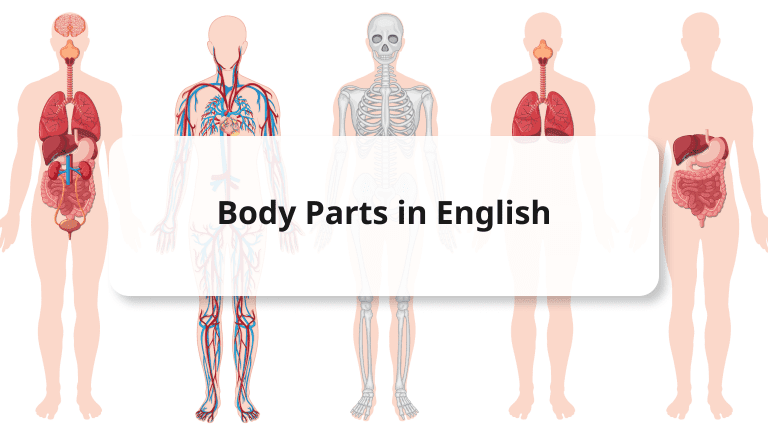Welcome to our guide on body parts in English! Whether you’re just starting to learn the language or looking to expand your vocabulary, understanding the words for different parts of the body is essential. In this article, we’ll introduce you to a wide range of body parts in English and provide tips for using them correctly. By the end, you’ll be able to describe yourself and others with confidence and precision.
Table of Contents
Basic Body Parts
Let’s start with the most basic body parts. These are words that you’ll use frequently in everyday conversation, so it’s important to learn them early on.
-
Head:
The top part of the body, contains the brain, eyes, ears, nose, and mouth.
-
Face:
The front part of the head, including the eyes, nose, and mouth.
-
Hair:
The thin, threadlike strands that grow from the skin’s surface, often on the head.
-
Ear:
One of two organs of hearing and balance, located on either side of the head.
-
Eye:
One of two organs of sight, located in the sockets of the skull.
-
Nose:
The organ of smell and one of the two organs of respiration, located in the middle of the face.
-
Mouth:
The opening through which food is taken in and vocalizations are made, surrounded by the lips.
-
Tooth:
One of a set of hard, bony enamel-coated structures in the jaws of most vertebrates, used for biting and chewing.
-
Tongue:
A muscular organ in the mouth that helps with tasting, swallowing, and speaking.
Upper Body Parts
Now let’s move on to the upper part of the body. These body parts are important for movement, communication, and sensory perception.
-
Shoulder:
The part of the body at the top of the arm where it is attached to the trunk.
-
Arm:
Each of the two upper limbs of the human body from the shoulder to the hand.
-
Elbow:
The joint between the upper arm and the lower arm.
-
Wrist:
The joint between the hand and the forearm.
-
Hand:
The terminal part of the human arm below the wrist, consisting of the fingers and the thumb.
-
Finger:
Any of the four slender jointed parts attached to each hand, used for grasping and holding.
-
Thumb:
The short, thick first digit of the human hand, used for grasping and holding.
-
Chest:
The front part of the body between the neck and the abdomen, containing the heart, lungs, and other organs.
-
Back:
The rear surface of the human body, from the neck to the lower end of the spine.
Lower Body Parts
Next, let’s take a look at the lower part of the body. These body parts are important for movement and balance.
-
Hip:
The projecting part on each side of the body, formed by the side of the pelvis and the upper part of the femur.
-
Thigh:
The part of the leg between the hip and the knee.
-
Knee:
The joint between the thigh and the lower leg.
-
Leg:
Each of the two lower limbs of the human body from the hip to the foot.
-
Ankle:
The joint between the foot and the leg.
-
Foot:
The lowermost part of the leg, on which a person or animal stands.
-
Toe:
Any of the five digits of the foot at the end of the toes.
Internal Body Parts
In addition to the external body parts we’ve covered so far, it’s also important to know the names of some internal organs and body systems. Here are a few examples:
-
Heart:
A muscular organ located in the chest that pumps blood throughout the body.
-
Lung:
One of a pair of organs in the chest that help us breathe.
-
Brain:
The organ inside the head that controls thought, memory, and sensation.
-
Stomach:
An organ in the body of a person or animal that stores and digests food.
-
Liver:
A large, reddish-brown organ in the body that helps with digestion and removes waste products.
-
Kidney:
Either of a pair of organs in the back part of the abdomen that filter the blood and produce urine.
-
Intestine:
The long, thin tube that extends from the stomach to the anus and helps with digestion and the absorption of nutrients.
Using Body Parts in English
Now that you’ve learned the names of various body parts in English, let’s practice using them in sentences. Here are a few examples:
-
“I have a headache.” (head)
-
“She has beautiful eyes.” (eyes)
-
“He has long arms.” (arms)
-
“I broke my arm when I fell.” (arm)
-
“She has a scar on her leg.” (leg)
-
“He hurt his ankle playing basketball.” (ankle)
In addition to using body parts as nouns, you can also use them as adjectives to describe people or things. For example:
-
“She has long, blonde hair.” (hair)
-
“He has a deep, booming voice.” (voice)
-
“I have a small, slender build.” (build)
Wrapping Up: A Recap of English Body Parts
We hope you’ve enjoyed learning about body parts in English and practicing using them in sentences. With a little practice, you’ll be able to describe yourself and others with confidence and precision. Whether you’re a beginner or an advanced learner, there’s always more to learn when it comes to expanding your vocabulary. For even more practice and personalized language lessons with native speakers, consider joining AmazingTalker. Keep studying and practicing, and you’ll be on your way to fluency in no time.
Discover the answers to your language-related questions on AmazingTalker’s Q&A page.
















